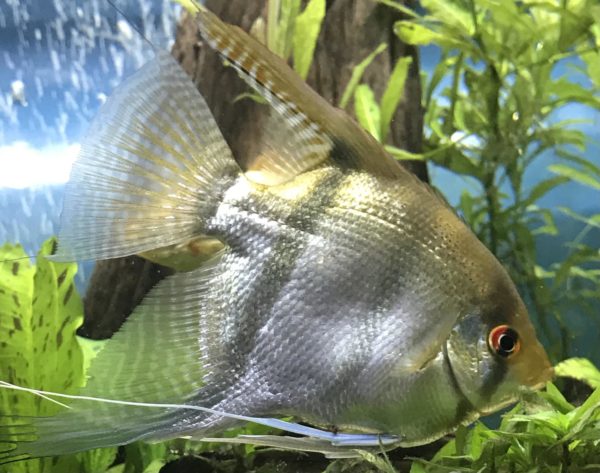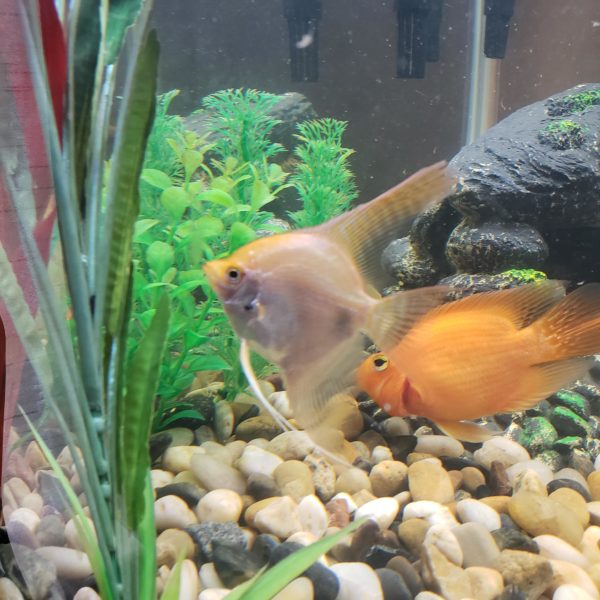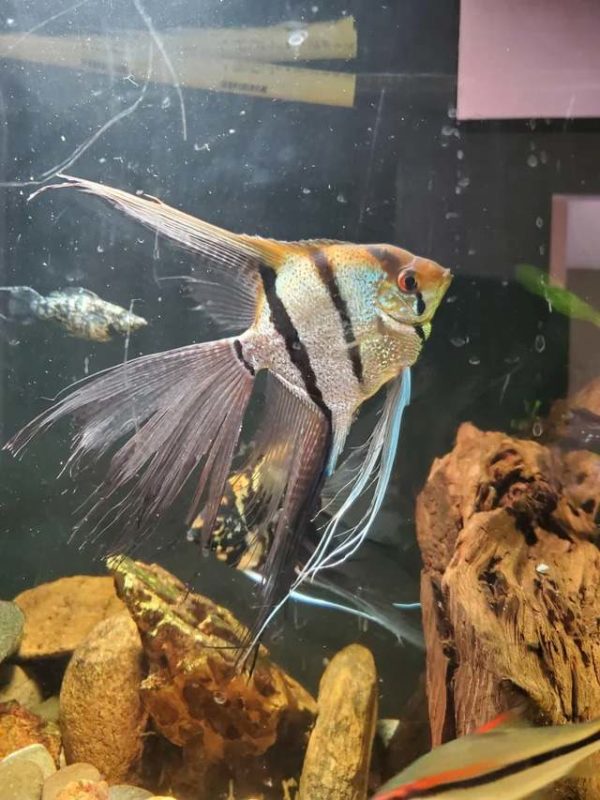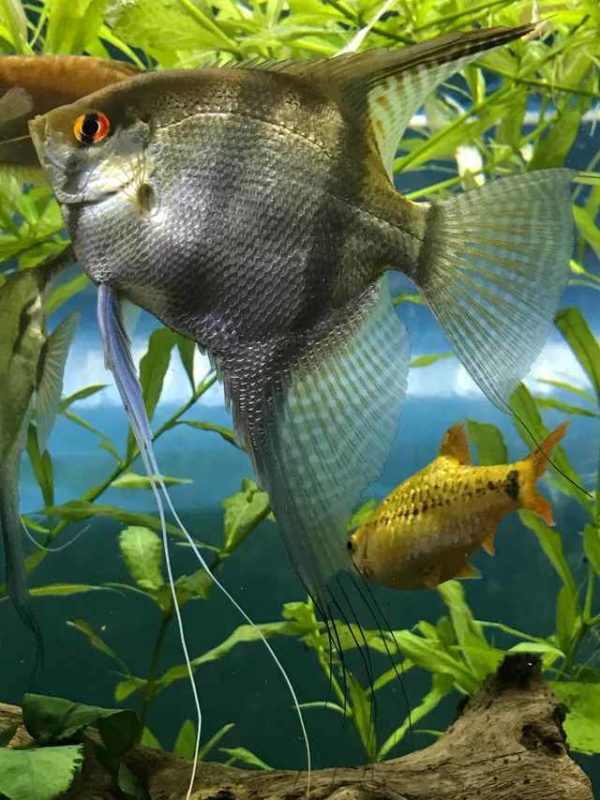Both beginner and advanced aquarists consistently look for unique fish species to add to their aquarium. Thanks to its unique traits, appearance, and behavior, Angelfish stands out as a popular species.
Not just for the visual effects, many advanced aquarists even keep angelfish in the tank to study their behavior and temperament. Despite their name, you’d be surprised to know that they are, in fact, aggressive.
Although not severe, angelfish can exhibit signs of aggression when they are under stress or don’t have favorable living conditions. They can also get territorial quickly, especially with the males. So, it is necessary to be cautious when homing angelfish in your aquarium.
This article will explore angelfish behavior and temperament to answer your queries better.
Table of Contents
Are Angelfish Aggressive?
Angelfish are generally not aggressive towards other fish, but they can be territorial and may exhibit aggressive behavior towards other angelfish, particularly during breeding season. It is important to properly research the compatibility of any new fish before introducing them to a tank with angelfish.
Facts About Keeping Angelfish
Before getting into their behavior, let us focus on their origin. Angelfish are native to South America, especially from the freshwater of the Amazon River.

Contrary to their name, angelfish aren’t angels and will show signs of aggression in the tank. So, don’t be surprised if you can’t keep them in community tanks for a prolonged period.
However, unlike other fish species, angelfish are pretty active and like to dominate the tank. You’d often find them zooming around the aquarium, trying to keep up with the area. They are very interactive and pleasant to stare at.
Also, if you are a beginner with little to no knowledge about fishkeeping, we’d recommend avoiding this species.
In terms of eating habits, they are carnivorous for the most part. They do nibble of plants now and then but don’t expect them to stay on an herbivore diet. Also, if smaller fish species are in the tank, they might be under threat from an angelfish.
However, their appearance and bright bands of blue make them stand out in the tank. The good thing about angelfish is that they are not demanding and like to keep to themselves.
With the right temperature and water parameters, an angelfish can grow up to ten inches in length, leaving them with a majestic appearance. Also, the sexual dimorphism between the two is difficult as they look identical.
They make good aquarium pets, thanks to their longer lifespan of up to 10 years. But, their breeding session is also quite fascinating to watch. So, if you are keeping angelfish to observe them, we recommend that you note that too.
What Causes Aggression in Angelfish?
Angelfish are aggressive and territorial by nature. Especially within the same species, their signs of aggression translate to the domination in the tank. With aggressive nature, they establish a potent hierarchy in the tank. So, you might find two or more angelfish in the tank trying to overpower the other.
However, there are additional causative factors besides that as well. For example, environmental factors and the sudden changes to the water parameters can also reflect their behavior.

Establishing dominance
Sudden changes to the water’s temperature, pH, or even complete change of the water disturb their established dominance in the water. So, to re-establish that, the fish might show specific signs of aggression.
Like most animals, even angelfish exert their dominance and mark their territory by peeing in the surroundings. So, when an aquarist changes the water, it eliminates that hierarchy, making it difficult for the angelfish to establish who is in maximum power in the tank.
Competition in the tank
Besides the same-species battles, angelfish also don’t entertain other aggressive fish species in the tank. So, if you are placing them in a community tank full of other aggressive fish, the angelfish will try to compete with them for dominance in the tank.
Inadequate diet
As we mentioned, angelfish is a carnivorous fish. This means they need a consistent supply of animal-based diet, including fish flakes, pellets, brine shrimp, etc.
Providing them with a poor or inadequate diet leaves them hungry in the tank. So, you might find them attacking smaller fish species for food.
Breeding season
Angelfish also become heavily aggressive during the breeding period, especially when the males are ready to mate the female fish.
The female angelfish might show signs of aggression just when they are ready to lay the eggs. So, make sure you keep an eye out on that as well.
What Are the Signs of Aggression Occurring?
The signs of aggression in angelfish will vary in different instances. This means that their behavior during mating is other than when they try to exert dominance.
As a fishkeeper, you need to know how to distinguish this behavior. Both behaviors are very similar but knowing the difference helps take necessary precautions.

During Mating
The male and female angelfish have very similar behavior during mating. The male angelfish typically chases the female one, nips their fins, and will also lock lips. Don’t mistake this as aggression. They are simply preparing themselves to mate.
The female angelfish can become very aggressive right before laying the eggs. You should thus separate the mating pair from the community tank during the breeding season.
Fighting for Dominance
Besides mating, the signs of aggression in an angelfish are prominent when fighting for dominance in the tank. During this time, the alpha males trying to exert dominance will hit the other angelfish with their tails, nip their fins, and even bite them.
This kind of aggression is short-lived, so you won’t have to worry about separating every fish from the tank. Once the dominance is established, the other angelfish will follow suit and scurry away from the dominant one in the tank.
Do Angelfish Fight Each Other?
Angelfish are territorial and like to assert their dominance in the tank. This can be with the same species or with competitor species too.
However, as an aquarist, you need to know that there are different types of angelfish are available in the market. Some are freshwater, and some are saltwater. So, pairing them together in a community tank won’t fair well.
An angelfish will start being aggressive when they aren’t comfortable with the living conditions. It could include frequent water changes, lack of food, or having other larger threatening fish species.
So, under such conditions, the different angelfish in the tank will start to fight each other to establish a favorable living condition for themselves.
How Do I Make My Angelfish Less Aggressive?
Angelfish are very complicated to reach and understand, so there’s no wonder why they aren’t a good option for the beginner aquarist.

The easiest way to make an angelfish less aggressive is by letting them be. Unfortunately, nature has its way of existing, which applies to the fish.
Sometimes, you need to analyze and understand the nature of the angelfish and assess the signs of aggression as part of their behavior. With the proper measures, you can effectively tame and reduce the aggressiveness but not eliminate it.
Following are some ways you can reduce the aggressiveness to an extent:
Find the culprit
The easiest way to manage the aggressiveness of an angelfish is to stay vigilant. You need to find the ones making the most chaos in the tank and then remove them from the area accordingly. Males tend to show more signs of aggression compared to female ones. So, if you have one in the tank showing similar signs, relocate them somewhere else.
Restrict frequent water changes
As we said, angelfish mark their territory of dominance by urinating or other excretory wastes. Frequent water changes completely nullify that, and the angelfish colony has to re-establish its hierarchy in the water. This is where you need to step in. Avoid changing the water frequently. However, at the same time, ensure that the tank is clean and doesn’t have unnecessary dirt and waste accumulation.
Maintain ideal water parameters
Both the temperature and the water current in the tank should be optimal for an angelfish. If the living conditions aren’t favorable, the same reflects on their well-being drastically. Also, if the aquarium’s water flow is strong, reduce it to match the requirements of the angelfish. Unregulated water parameters put the angelfish under stress, which forces them to become aggressive.
Check our article on ‘15 Different Types Of Freshwater Angelfish‘.
Proper feeding habit
Hungry angelfish get aggressive very quickly in the tank. It can even lead to situations where they eat their smaller tankmates. So, keep up with their feeding every day to ensure they aren’t hungry. Proper nourishment contributes to calm and nurturing behavior.
Remove during breeding
The last thing you want to do is breed your angelfish in a community tank with other species. Female angelfish are at their peak aggressiveness during this period and will nip and bite other fish that come their way. So, try to separate your mating fish pair during their breeding period.
FAQs
Angelfish are generally carnivorous and rely on fish pellets, flakes, and shrimps for their meals. They rarely depend on plants. So, it isn’t surprising that they can eat other fish in the tank, especially those smaller than them. They also eat the fry.
Angelfish have a habit of biting both fish and humans. While the bites can be fatal for the smaller fish species, it isn’t anything worse than a nibble for humans. We’d recommend you not put your bare hands in contact with the fish since it might lead to later complications.
Angelfish lock lips and nip each other when they are mating. This is a behavioral trait many aquarists mistake for fighting and aggression. However, if you find one of the two with a bulging stomach and ready to lay eggs, be assured that they are in the mating process.
Angelfish can become aggressive to their kind, especially when trying to establish dominance in the tank. They won’t necessarily fight them to eat, but they can bite and nip their fins.
Conclusion
Keeping angelfish in your home aquarium is a rewarding experience. However, it comes with a lot of complications and demands. Not only should you have preconceived knowledge about their care, but you should also be aware of their different traits and mating behavior to care for them the right way.
This article explains every aspect of your angelfish behavior and aggression. If you have any further queries, feel free to leave them for us in the comments.
